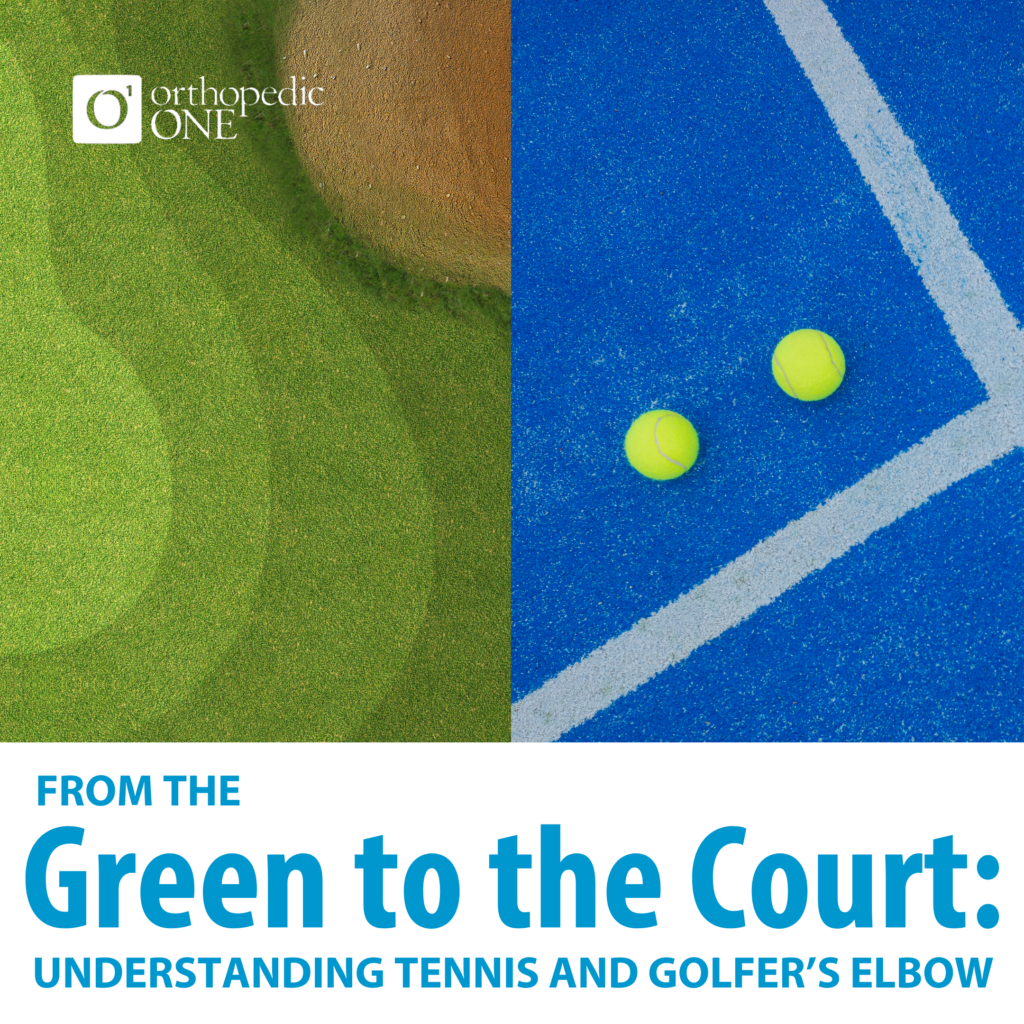From the Green to the Court: Understanding Tennis and Golfer’s Elbow
As the US Open captivates tennis fans across the globe, it’s the perfect time to delve into two common—yet often misunderstood—elbow injuries: tennis elbow and golfer’s elbow. Despite their names, these conditions can affect anyone, not just those swinging a tennis racket or a golf club. Understanding the differences between them, how to prevent injury, and when to seek help from an Orthopedic ONE specialist is key to maintaining elbow health and avoiding chronic pain.

Tennis Elbow: The Outer Side
Tennis elbow (lateral epicondylitis) is a condition characterized by inflammation of the tendons connecting the forearm muscles to the outer elbow. But this condition isn’t limited to tennis players! In fact, it’s quite prevalent among individuals who engage in repetitive wrist and arm movements, such as plumbers, carpenters, painters, and butchers. The repeated stress on the extensor tendons—the tendons responsible for extending the wrist and fingers—leads to tiny tears, resulting in inflammation, pain, and tenderness.
Typically affecting people between 30-50 years of age, tennis elbow manifests as pain that radiates from the outer elbow down the forearm and wrist. This pain can make simple actions like gripping objects or shaking hands uncomfortable and challenging. Common treatments include rest, icing, taking anti-inflammatory medications, and performing specific stretching exercises.
In more severe cases, a physician might recommend using an arm brace or wrist splint, physical therapy, massage, or even orthobiologics to alleviate pain and promote healing.
Golfer’s Elbow: The Inner Side
Golfer’s elbow (medial epicondylitis) affects the tendons connecting the forearm muscles to the inner elbow. This condition primarily involves the flexor muscles, which control the flexion of the wrist and fingers. Much like tennis elbow, golfer’s elbow results from repetitive stress and overuse, leading to tiny tears in the tendons that anchor the flexor muscles to the medial epicondyle.
While the name suggests a strong association with golf, this condition also affects those engaged in racquet sports, throwing sports like baseball and football, weight training, and repetitive occupational activities. Pain is typically felt on the inner side of the elbow and can extend down the forearm, often accompanied by stiffness, tingling, weakness, and numbness. The symptoms can develop gradually or appear suddenly after intense activity.
In short, tennis elbow is associated with the outer elbow, while golfer’s elbow is associated with the inner elbow. Fortunately, there are a number of ways you can work to prevent the development of these conditions!
Prevention Tips for Pain-Free Elbows
Preventing tennis elbow and golfer’s elbow involves a combination of proper technique, adequate conditioning, and mindful activity modification. We’ve compiled a list of tips to help you fend off these painful conditions:
- Strengthening exercises: Regularly perform exercises to strengthen the forearm muscles, as stronger muscles are better equipped to handle stress and repetitive motions.
- Proper technique: Whether you’re playing a sport or performing a repetitive task at work, using the correct technique can reduce the strain on your tendons. If you want to ensure you’re using the right form, the team at Orthopedic ONE can help.
- Warm-up and stretching: Always warm up before any physical activity and incorporate stretching exercises to maintain flexibility and reduce the risk of injury.
- Gradual progression: Avoid sudden increases in the intensity or duration of your activities. Gradual progression allows your muscles and tendons to adapt without becoming overstressed.
When to Seek Specialist Support
While minor aches and pains can typically be managed with rest and over-the-counter treatments, persistent or severe symptoms warrant a visit to one of our specialists at Orthopedic ONE. If you’re experiencing any of the following, get in touch with our team. We’re here to support you throughout every step of your journey to healthier, less painful movement.
- Chronic pain: If pain persists despite home treatment, it’s essential to consult a specialist to prevent further damage.
- Reduced function: Difficulty performing everyday tasks, such as gripping objects or lifting, indicates a need for professional evaluation.
- Severe symptoms: Intense pain, significant swelling, or sudden weakness in the hand or forearm should be promptly addressed by a healthcare provider.
- Lack of improvement: If your symptoms haven’t improved after a few weeks of conservative treatment, an Orthopedic ONE specialist can provide additional treatment options and develop a more targeted recovery plan.
Whether you’re an athlete or someone with a job that requires repetitive arm movements, taking proactive steps and knowing when to seek professional help are essential for staying pain-free and active. As you enjoy the excitement of the US Open, keep these tips in mind to ensure your elbows remain strong and healthy!
Sources: